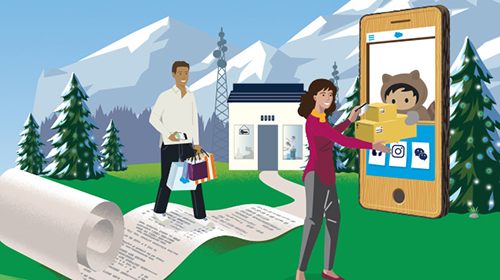It’s no secret that the retail experience has seen a massive upheaval as a whole, but how are some retailers managing to thrive in this new world, while others are struggling?
To discover what’s driving the retail divide, Salesforce surveyed over 10,000 consumers from around the globe to find out:
- How retailers, brands and online marketplaces can make their voices heard in an increasingly crowded retail landscape.
- What the primary drivers for customer loyalty are.
- How retailers can compete with the emergence of digital purchase points.
- How physical stores can evolve to meet new customer needs.
The results of the research, presented in the Connected Shoppers Report, offer a useful glimpse into consumer expectations, and we’ve highlighted four key trends below.
An epic war for wallet share in today’s retail industry is already being waged across an array of digital battlefields.
From the numbers above, it’s evident that online marketplaces remain the dominant force in digital shopping, but retailers and brands have become formidable competitors. Eighty-six percent of shoppers use retailers, brands and online marketplaces, as each channel offers its own unique benefits and selling points.
Shoppers are often drawn to retailers for their rewards programmes, superior customer service and no-hassle return policies. Brands stand out for their high-quality, unique or customisable products, while online marketplaces are king when it comes to price, convenience and product selection.
Now, more than ever, customers expect to be understood.
With so many businesses vying for their attention, customers want to engage with companies that understand them and anticipate their individual needs, on their preferred platform.
Exclusive retail experiences and promotions are an invaluable way for brands to build a connection with the customer, and over 80% of consumers are more likely to do business with brands that offer loyalty programmes.
As customer behaviour evolves, so must the retail industry.
The landscape for the customer journey has shifted and new lines of engagement have been drawn, but one thing is clear: the future of shopping will transcend the retail industry’s physical and digital properties.
Third-party channels, including gaming consoles, AI assistants and social media sites, will continue to grow and provide retailers with new frontiers for building relationships, promoting branded content and carrying out transactions.
Today, nearly 10% of transactions occur on emerging digital purchase points – this is
referred to as ‘shopping at the edge’. Whether they’re asking Alexa to order a pizza, booking a holiday through Whatsapp or buying a leather jacket on Instagram, more and more customers are shopping at the edge by using these off-property channels.
Brick-and-mortar stores are still crucial.
The retail industry is in the midst of full-scale digital transformation, but stores remain critical for discovery, experience and fulfilment. As a matter of fact, 81% of shoppers still turn to brick-and-mortar locations to discover and evaluate new products.
Stores offer something that the digital domain can’t – a tactile shopping journey and in-person customer engagement. Shoppers seek out stores that offer unique experiences, not just products and checkout lines, so the store’s ability to provide a personalised retail experience is paramount, especially if it transcends the transactional and moves into the realm of relationship building.
It’s hard to overstate the impact of mobile devices on brick-and-mortar shops, as 3 out of 4 Gen Z shoppers state that they’ve researched products on a mobile device while in-store. But despite paradigm-shifting innovations like mobile wallets, many stores aren’t evolving to match shoppers’ increasingly mobile mindsets.
To get more insights into the mindsets of shoppers, download the complete Connected Shoppers Report.




